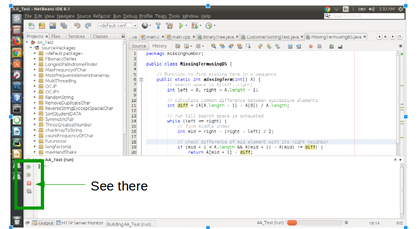在Java,有两种类型的线程:
- 守护线程
- 用户线程
守护线程是总是在后台运行的低优先级线程,而用户线程是总是在前台运行的高优先级线程。用户线程或非守护进程旨在执行特定或复杂的任务,其中守护进程线程用于执行支持任务。
Java守护线程和用户线程的区别
- JVM 不等待守护线程完成,而是等待用户线程:守护线程和用户线程之间的首要区别在于,JVM 不会等待守护线程完成其任务,而是等待任何活动的用户线程。
例如,在 NetBeans 中运行Java程序时可能已经注意到这种行为,即使主线程已完成,左上角的向下按钮仍然是红色的,表明Java程序仍在运行。这是由于从主线程产生的任何用户线程,但在主线程中,在 NetBeans 中看不到那个红点。
- 线程优先级:与守护线程相比,用户线程具有高优先级,这意味着它们不会像用户线程那样容易获得 CPU。
- 创建线程:用户线程通常由应用程序创建,用于并发执行某些任务。另一方面,守护线程主要由 JVM 创建,就像一些垃圾收集作业一样。
- 线程终止:JVM将迫使守护线程终止,如果所有用户线程都执行完毕,但用户线程是通过应用程序或通过自我封闭。用户线程可以由 JVM 运行保持运行,但守护线程不能由 JVM 保持运行。这是用户线程和守护线程之间最关键的区别。
- 用法:守护线程不用于任何关键任务。任何重要的任务都由用户线程完成。守护线程一般用于一些非关键任务的后台任务。
用户线程和守护线程的主要区别:
| User Thread | Daemon Thread |
|---|---|
| JVM wait until user threads to finish their work. It never exit until all user threads finish their work. | The JVM will’t wait for daemon threads to finish their work. The JVM will exit as soon as all user threads finish their work. |
| JVM will not force to user threads for terminating, so JVM will wait for user threads to terminate themselves. | If all user threads have finished their work JVM will force the daemon threads to terminate |
| User threads are created by the application. | Mostly Daemon threads created by the JVM. |
| Mainly user threads are designed to do some specific task. | Daemon threads are design as to support the user threads. |
| User threads are foreground threads. | Daemon threads are background threads. |
| User threads are high priority threads. | Daemon threads are low priority threads. |
| Its life independent. | Its life depends on user threads. |
示例:检查线程是否为守护进程
可以使用 setDaemon(boolean) 方法将用户线程设为守护线程。在这个例子中,使用 isDaemon() 方法检查线程类型(用户线程或守护线程)。如果它是守护进程则返回真,否则返回假。
// Java program check thread is Daemon or not
class MyThread extends Thread {
@Override
public void run()
{
System.out.println("User Thread or Non-Daemon Thread");
}
}
class MainThread {
public static void main(String[] args)
{
MyThread mt = new MyThread();
mt.start();
System.out.println("Main Thread");
System.out.println("Is " + mt.getName()
+ " a Daemon Thread: "
+ mt.isDaemon());
System.out.println("Is " + Thread.currentThread().getName()
+ " a Daemon Thread: "
+ Thread.currentThread().isDaemon());
}
}
输出:
Main Thread
Is Thread-0 a Daemon Thread: false
Is main a Daemon Thread: false
User Thread or Non-Daemon Thread
示例:将非守护线程设为守护线程:
在此示例中,使用 setDeamon(boolean) 将非守护程序线程设为守护程序。
// Java program make user thread as a daemon thread
class MyThread extends Thread {
@Override
public void run()
{
System.out.println("Non-Daemon thread");
}
}
class MainThread {
public static void main(String[] args)
{
MyThread mt = new MyThread();
System.out.println("Before using setDaemon() method: ");
System.out.println("Is " + mt.getName()
+ " a Daemon Thread: "
+ mt.isDaemon());
mt.setDaemon(true);
System.out.println("After using setDaemon() method: ");
System.out.println("Is " + mt.getName()
+ " a Daemon Thread: "
+ mt.isDaemon());
}
}
输出:
Before using setDaemon() method:
Is Thread-0 a Daemon Thread: false
After using setDaemon() method:
Is Thread-0 a Daemon Thread: true